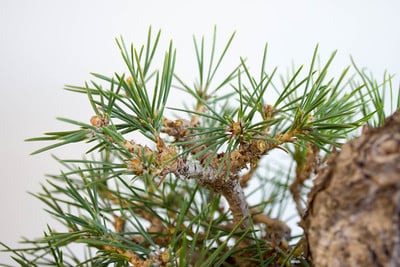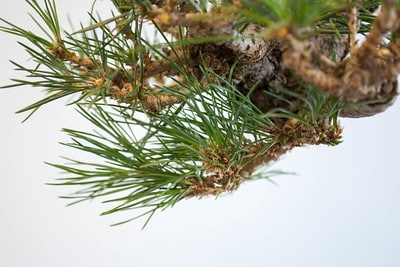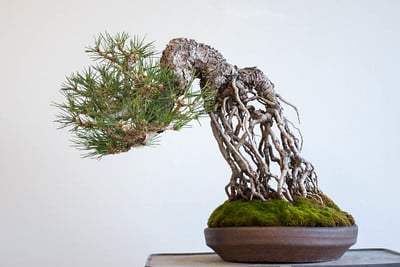Density is a key concept in bonsai. We want young trees to develop good density. With mature trees, we aim to maintain density. Density, it seems, rarely takes care of itself.
Some of the young pines I’m developing have been decandled for the past several years. This has dramatically increased the trees’ density.

Dense foliage on 12 year-old black pine
If such density were maintained throughout the year, interior branches would quickly die out and no new shoots would appear to take their place. Without interior shoots, maintaining the current silhouette would not be possible.
The best way to keep interior shoots happy and encourage new buds is to provide as much light as possible in the tree’s interior. Branch cutback and needle-pulling are the primary vehicles for achieving this.
Branch cutback is the art of creating attractive and sustainable branch structure. Needle-pulling is more straightforward. By removing needles we reduce foliage density – good for letting light into the tree’s interior – and also reduce the tree’s ability to produce food – good for producing refined growth.
The best time of the year to pull needles on black or red pines is when the needles are mature – fall through early spring. For trees that have been decandled, needles can also be removed at decandling time.
After decandling this exposed-root pine, I began removing needles from strongest shoots.

After removing extra needles from the tree’s apex
In most areas, I left between 5-7 pairs of needles. The very bottom branch, however, is significantly weaker than the others so I opted to not decandle and removed very few needles.

Low branch after removing a few needles
Removing needles makes it easy to see the structure of the tree. This is one reason why pines are often wired after they are decandled.
The other reason decandling time is great for wiring pines is that the resulting summer growth will all point upward. This can give pines a natural feeling that’s hard to accomplish with wiring alone.

After decandling and needle-plucking
The window during which pines can be wired after decandling is short as new shoots can appear within a week or two of decandling. Once these new shoots appear, great care must be taken when wiring to avoid damaging new buds. For this reason, when summer buds appear it’s best to postpone wiring until fall at which point the summer foliage will be mature.
Subscribe to Bonsai Tonight
New Posts Delivered Every Tuesday and Friday
Danny Powell says
Hi Jonas, apologies in advance for nit-picking as I know this tree is still very much in development, but do you have any plans for the straight section leading to the apex? I know before de-candling it was hidden and I would assume it will be so again after new growth emerges.
Also, I’m impressed with the moss, does that grow naturally in your climate? Even being only an hour south of you I could never imagine being able to grow that much moss in a pot naturally, especially on a pine. Thanks in advance.
Jonas Dupuich says
Hi Danny – good questions. Yes, I have a plan – two actually – for the straight section you mention. Friday’s post may provide the answer.
The moss was applied for this year’s BIB show – I’ve left it in place as it helps keep the soil from washing away.
James Gielow says
Beautiful! Was this over a rock at one point? How did you get the roots to develop like that?
Jonas Dupuich says
Thanks James! The tree was trained in the exposed root style from seed. Here’s a peek at the first step in the process – planting the seedling in a deep container with large soul particles. Over time the soil is reduced leaving the roots exposed.
https://bonsaitonight.com/2013/03/26/repotting-1-year-old-black-pine-seedlings/
James Gielow says
Wow! Fascinating process!Thank you for sharing that.
Jonas Dupuich says
@Danny – update about the straight section: the two options were to remove the branch or to wire it. I plan to do both. I’ve wired it for now, but I’ll likely remove it in the future.
Danny says
@Jonas – thanks for the update. Why wire it if you’re planning on removing it? Aesthetics for the short term?
Jonas Dupuich says
Good question Danny! The main reason for keeping the branch is to distribute summer growth into as many branches as possible as I’m looking to produce more refined shoots. Once there are more total shoots, the tree will develop more slowly and removing the branch will have less of an effect.